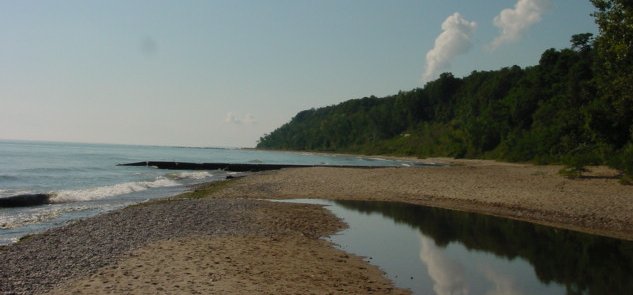The helicopter ride from AA takes around an hour. You need around forty-five minutes to convoy from our base at El Dorado (formerly COP Norseman) to the Village of Nathara near Rutbah. The ride there was bumpy and a little unpleasant. The trip home was even worse. I felt queasy, as did the others on the flight, but nobody got sick. The EXO told me that should I ever actually become sick, I would be called “Chunks” from then on. It is a powerful incentive to avoid messing up the helicopter floor.
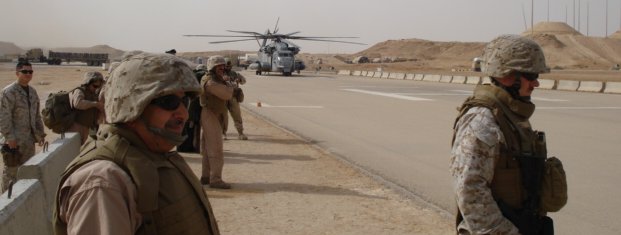
We went there to deal with a local matter involving Marines. This is a barren area in a barren region. The township covers 172 square kilometers of dirt and gravel on top of a plateau around 700 meters above sea level. The elevation and topography mean that it is not as hot here as in the WERV. Besides that, however, it enjoys no advantages. Houses of the village are widely spaced. I have no idea why they do that. There is nothing between them and the spacing makes it difficult to get around. I suppose everybody wants his space. Buildings are made of a kind of a plaster/mud/concrete mix with facades of stone. Most of the houses are small, but there are lots of people per unit, since most of the local men have more than one wife and lots of children.
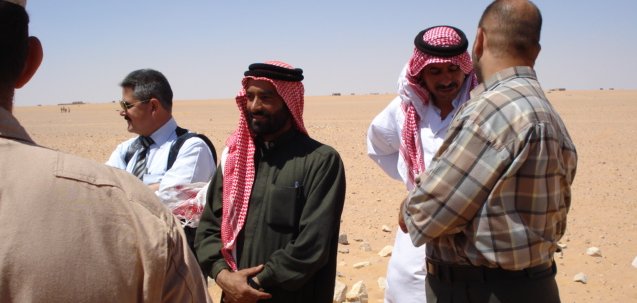
We shared the MRAP ride with Mayor of Rutbah and his associates. They talked a little about the regional problems, not surprisingly sheep, water and fuel. We hear that trinity of trouble everyplace we go. The problems are interrelated and most likely unsolvable in the short run and beyond our control in any case. Rain will mitigate the sheep/water conditions; fuel will require market prices.
Along the way we had to drive thorough a dry wadi to bypass a collapsed bridge. CF had destroyed it early in the conflict as part of the shock and awe campaign. The mayor pointed out that it was not very shocking and inspired little awe since this particular bridge was so isolated and it was relatively easy to drive around. I don’t know much about bridges and as I looked at the supports I could not tell how easy it would be to repair the structure, but I am not sure they need a bridge there at all. I suppose that is why there is no urgency about making repairs. On the rare occasions when it rains, the wadi would be impassible for a couple of hours, but I bet culverts could take care of that.

We met the local sheik and his entourage when we got to Nathara. The imam also showed up. We had not expected him because he was reportedly sick, but he insisted that when he heard about our visit he had to come to see his friends. He evidently has some kind of bronchitis, but didn’t seem very sick and whatever ailed him did not interfere with his socializing. He greeted our Chaplin very warmly and with genuine affection. They spoke a little about Christianity, Islam and Judaism all being Abrahamic religions making all of us brothers. This brotherhood thing is very important around here. It is used fairly loosely and I am uncertain of its real significance.
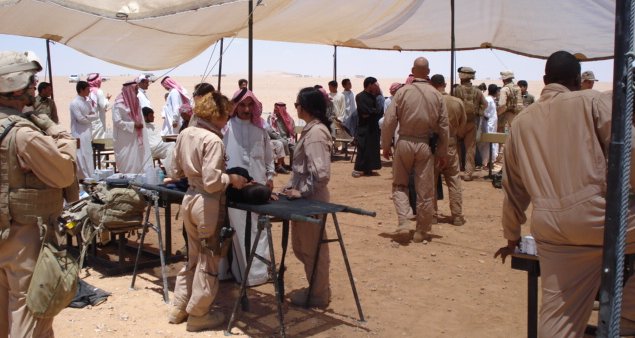
The Marines took the opportunity to set up a local health screening. Iraqis do not have access to much heath care. Even the rich sheiks like to get American medical opinions. The poorer people we served on this visit may never have seen a competent doctor. Men brought in their sons. A big challenge is women’s health. That is why we brought female doctors. This is a conservative area and women are not allowed to talk to strangers. Colonel Malay asked the local sheik and the neighborhood imam to help get women to come. Both promised to do what they could, cautioning however that women might choose not to come. The imam even promised to preach re during Friday services in his mosque, but we don’t expect a high turnout.
Below is stonework in the buildings.

The imam mentioned that he personally could use a checkup and maybe some medication to help with his breathing problem.
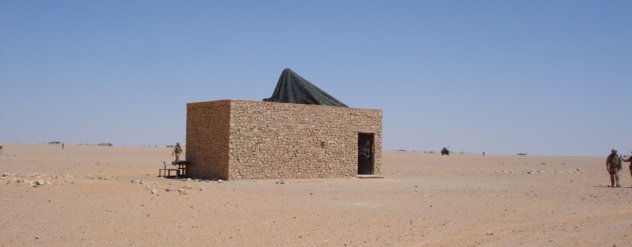
Villagers were friendly and local leaders are supportive of the Marines, who they know protect them from insurgent attacks. They told us that they recognize any outsiders trying to infiltrate into their area and report what they know. Bad guys are still hanging around in the deserts and the wadis and some are crossing the borders. The vast distances and sparse population make this a good place to hide, but the atmosphere is much improved.
Local authorities were anxious to talk to me because they knew that our ePRT had helped with wells and animal health in nearby places. I will ask Dennis to assess potential here, but my own observations tell me that we will not be able to do very much. A short observation of the local soils and topography did not make me sanguine re the prospects. The land falls off in all directions from the place we were standing and a look at the map does not reveal any likely sources for an aquifer. Dennis told me that there is indeed water in the area, but it probably not sufficient and it is 250-300 meters down. Beyond that, the water to the west is evidently so full of dissolved salts that it is brackish and unsuitable for consumption. The soil looks okay, seems to have a lot of iron, but it is just dry dust. It would be wrong to say that there is not a blade of grass, but there is not much more than that.
This situation in Iraq’s western desert is emblematic of a coming world crisis in water. It is just more acute here sooner. In the 1940s, Iraq had a population of less than five million. The land and its water resources could sustain a population that big. Now there are twenty-eight million Iraqis and the population is expanding fast, fastest out here in the western deserts where there is not much to drink even in a wet year – which we see only once in every 5-7 seasons. The population of sheep and goats has expanded along with the population. The number of animals is well above the carrying capacity. We can advise on improvements and make things better, but trying to find more water for more sheep as well as more people and more irrigation is not a sustainable solution in the long run in all places.
The natural condition of this desert is to be mostly empty. There is little here that would attract population and maybe it should stay that way. Don’t get me wrong. I firmly believe in making improvements. Some parts of our AO cry out for just a little water and some smart agriculture. Along the WERV there are Eden-like places that could supply high quality fruits and vegetables sustainably and in very large quantities. All they need is the initial investments and better management. The high desert we were in yesterday is not such a place. Sometimes you need to recognize what shouldn’t be done.
All that said, we CAN help with a well and we probably will. It will enhance Nathara’s prospects at least a short time. Perhaps it will buy enough time for the people to make an adjustment. No, I don’t think so easier, but hope is trumping experience. On the plus side, one of the local leaders complained that the sheep herds were significantly smaller and that people were being forced to sell off large parts of their herds. Of course, that is exactly what must happen. I regret that hardship is creating this solution, but it is nonetheless the right direction.
Below is not Iraq. That is lake Michigan, Grant Park in South Milwaukee Lots of water and very pretty. I just put that in for contrast and because I like it.
